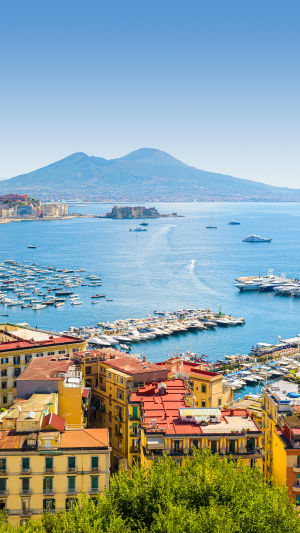Mount Vesuvius is a famous and active volcano located on the Mediterranean coast of Europe, near the city of Naples, Italy. Standing at a height of nearly 1,300 meters, Vesuvius has been the site of frequent geological activity for thousands of years.
Vesuvius has a long and storied history of eruptions, with records of nearly 20 eruptions taking place from the 15th century to the present day. The most famous and devastating eruption of Vesuvius occurred in 79 AD when it completely destroyed the city of Pompeii.
Volcanic eruptions are caused by the Earth's internal forces, and the magma that forms these eruptions is believed to come from the layer of soft fluid that lies 80 km to 400 km below the Earth's surface.
At this depth, the decay of radioactive elements in the Earth releases large amounts of heat energy, causing the rocks to melt and form molten magma. The magma rises along fractures in the Earth's plates and eventually reaches the surface, leading to a volcanic eruption.
Vesuvius is located on the boundary between the African plate and the Asian and European plates, an area known for its active volcanoes, including Mount Etna, which is the most frequently erupting volcano in the world.
Today, Vesuvius is a popular tourist destination, attracting visitors from all over the world to the city of Naples. With its endless seashore, cloudless blue sky, and majestic and mysterious volcano, Naples is often referred to as a city "worth dying for" by Italians.
In addition to its historical and geological significance, Vesuvius also plays an important role in the local ecosystem and economy. The volcanic soil in the area is highly fertile and is used for agriculture.
The area around Vesuvius is also home to a number of unique plant and animal species that have adapted to the unique environmental conditions created by the volcano.
Despite its importance, Vesuvius and its surrounding area are also threatened by a number of environmental and man-made hazards. The increased human settlement and development in the area have put a strain on the local ecosystem, leading to soil erosion and deforestation. In addition, there is a risk of volcanic mudflows, which can cause significant damage to nearby towns and cities.
To mitigate these risks, there are a number of measures being taken by local authorities and conservation groups. These include the creation of protected areas around Vesuvius, efforts to reduce soil erosion and deforestation, and the development of early warning systems to alert residents in the event of a volcanic eruption.
Despite these efforts, Vesuvius remains an active and potentially dangerous volcano. It is important for visitors and residents alike to be aware of the risks associated with this natural wonder and to follow safety guidelines when visiting the area.
Whether you are a scientist, historian, or simply a nature lover, Vesuvius is a site that should not be missed. Its combination of beauty, history, and geological significance make it a unique and fascinating destination that offers a glimpse into the powerful forces that shape our planet.





